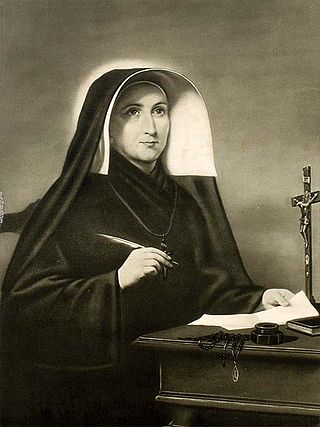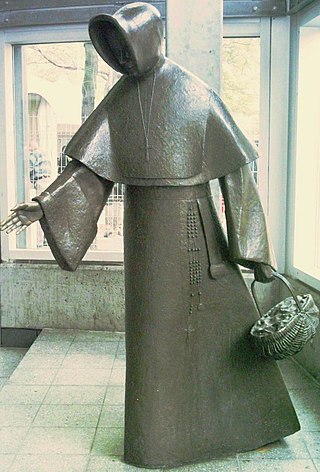
Blessed Antonio Francesco Davide Ambrogio Rosmini-Serbati was an Italian Roman Catholic priest and philosopher. He founded the Rosminians, officially the Institute of Charity or Societas a charitate nuncupata, pioneered the concept of social justice, and Italian Liberal Catholicism. Alessandro Manzoni considered Rosmini the only contemporary Italian author worth reading.
The Franciscan Sisters of Christian Charity are a Congregation of Roman Catholic apostolic religious women. The congregation was founded in 1869 in Manitowoc, Wisconsin in the Roman Catholic Archdiocese of Milwaukee, later part of the Roman Catholic Diocese of Green Bay. The sisters have active apostolates in education, health care, spiritual direction, and other community ministries. As of 2021, there are 188 sisters in the community. The FSCC is a member of the Council of Major Superiors of Women Religious, an organization which represents women religious in the United States.

The Sisters of St. Joseph, also known as the Congregation of the Sisters of St. Joseph, abbreviated CSJ or SSJ, is a Roman Catholic religious congregation of women founded in Le Puy-en-Velay, France, in 1650. This congregation, named for Saint Joseph, has approximately 14,000 members worldwide: about 7,000 in the United States; 2,000 in France; and are active in 50 other countries.
The Brothers of the Sacred Heart is a Catholic lay religious congregation of Pontifical Right for Men founded by the Reverend Fr. André Coindre (1787–1826) in 1821. Its Constitution was modeled upon that of the Jesuits, while its Rule of Life was based upon the Rule of Saint Augustine. Its members bind themselves for life by simple vows of religion. Its members add the nominal S.C. after their names to indicate their membership in the congregation.

The Congregation of the Religious of the Virgin Mary (Spanish: Religiosas de la Beata Virgen María, abbreviated RVM, is a Roman Catholic centralized religious institute of consecrated life of Pontifical Right for women founded in Manila in 1684 by the Filipina Venerable Mother Ignacia del Espíritu Santo.
Jacques-François Dujarié (1767-1838) was a French Catholic priest who served the people of France at the start of the 19th century. To this end, he founded a congregation of Religious Sisters and another one of Brothers.
The Third Order of Saint Francis is a third order in the Franciscan tradition of Christianity, founded by the medieval Italian Catholic friar Francis of Assisi.

Jean-Marie Robert de La Mennais, FICP was a Breton Catholic priest and brother of the philosopher Felicité Robert de Lamennais, whom he influenced in their youth. He was a leading figure in the revival of the Catholic Church in France after the French Revolution, involved in founding three religious institutes as part of this effort.
The Rosminians, officially named the Institute of Charity, abbreviated I.C., are a Roman Catholic clerical religious congregation of Pontifical Right for men founded by Antonio Rosmini and first organised in 1828.

Aloysius Luigi Gentili was an Italian Rosminian cleric.

The Oblate Sisters of Providence (OSP) is a Catholic women's religious institute founded by Mother Mary Elizabeth Lange, and James Nicholas Joubert in 1829 in Baltimore, Maryland for the education of girls of African descent. It was the first permanent community of Black Catholic sisters in the United States.

The Congregation of Divine Providence is the name of two Roman Catholic religious institutes of women which have developed from the work of Jean-Martin Moye (1730-1793), a French Catholic priest. They are dedicated to the instruction and care of the neediest of the world.

Loughborough Amherst School, formerly known as Our Lady's Convent School (OLCS), is an independent day school for girls and boys aged 4 to 18. It is situated in Loughborough, UK. It is founded on traditional Christian principles and embraces all faiths.

Joan Elizabeth Lucy Bichier des Âges was a French religious sister, commonly referred to as Elizabeth Bichier. Together with Andrew Fournet, she founded the Sisters of the Cross, Sisters of St. Andrew, a religious congregation which was established for the care of the poor and the instruction of rural children in the Diocese of Poitiers in 1807. She also helped to inspire the founding of a community of priests dedicated to missionary service, the Congregation of the Sacred Heart of Jesus of Betharram. She has been declared a saint by the Catholic Church.

The Religious of Jesus and Mary, abbreviated as R.J.M., form a Roman Catholic religious congregation of women dedicated to the education and service of the poor. It was founded at Lyon, France, in October 1818, by Claudine Thévenet.
The Sisters of St. Anne (S.S.A.) is a Roman Catholic religious institute, founded in 1850 in Vaudreuil, Quebec, Canada, by the Blessed Marie Anne Blondin, S.S.A., to promote the education of the rural children of the Province of Canada. Their vision is rooted and guided by Ignatian spirituality.
Sisters of Providence may refer to a number of congregations of Religious Sisters:

Émilie Tavernier Gamelin was a Canadian social worker and Roman Catholic religious sister. She is best known as the founder of the Sisters of Providence of Montreal. In 2001 she was beatified by Pope John Paul II.

Marie Anne Blondin, SSA, was a Canadian teacher who became the foundress of the Sisters of Saint Anne, established in 1850 and dedicated to educating the rural population of the Province of Canada. She has been beatified by the Catholic Church.











